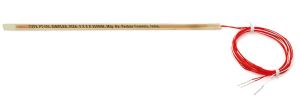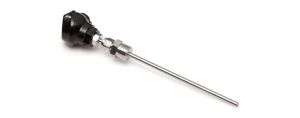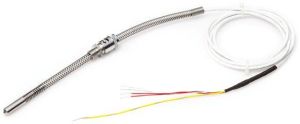
Wire wound RTD elements
General description for RTD elements Temperature is one of the important basic or fundamental quantity of a matter and it defines the thermal energy of the matter. It is measured in various units like °C, °F, and °K. All these units are quite well defined by International Temperature scale ITS 90. Among various methods of temperature measurements, thermocouples, resistance thermometers and thermistors are most popular. The reason being they provide electrical signals, which can be connected to, sophisticated indicating, controlling and recording instruments. Over the range of –200 deg c to +962 deg C, accepted standards is the Standard PRT i.e. Platinum Resistance Thermometers. The basic principle of resistance thermometry is that the resistively of metal depends upon it’s temperature. It is an absolute method of measurement (As compared to thermocouple which measures temperature difference) For a particular metal, a curve can be obtained for resistance versus temperature. The base metal used in resistance thermometry are Platinum, Copper and Nickel. Since early days, resistance thermometry has gone to considerable changes and they are now extensively used in industries. At temperature below 650 deg C, the industrial resistance thermometer are now more accurate and reliable than any other sensors. The increase in use of microcontroller based linearised instruments increases the choice of RTDs . Among all the base metals, Platinum is now a days the best choice in the industries. Platinum being a noble metal retains its characteristics for longer time. For wide temperature range Platinum Resistance thermometer follows the equation as defined below, Rt = Ro(1+At + Bt ) Where Rt = Resistance at temperature t Ro = Resistance at 0 Deg C temperature A and B are alpha and beta values of Platinum resistors. Various construction of RTD elements RTD elements are available in three type of construction Thin film type Thick film type Wire wound RTD element Film technology Thick film is produced by spreading Platinum paste through a silk screen onto a ceramic substrate. Thin film is produced by evaporation of metal onto a substrate and then by suitably itching with LASER technology The basic advantages of both types are they are mass produced elements, they are cheaper as well as they can work in environment. Where extreme vibration is presence The disadvantage of these elements are The film is covered rigidly by glass layer and so the Platinum is not free to expand. The result is they can not maintain characteristics specially at higher Temperature The film contains very little metal and hence there are more chance of contamination from the impurities of the glass covering. The unit have very little size and mass is also small. Hence they are subject to self heating error when sensing current is pass through it. Control of homogenous of metal is difficult as compared to wire used in wire wound elements Wire Wound RTD elements Wire wound elements are basically a “hand made“ product which involves lot of skilled Labour. It is manufactured by placing a coil of thin wire (7 microns to 35 microns) into a ceramic insulator. The resistance of the coil is suitably adjusted to the ohms corresponding to that particular temperature. Ideally, this coil should be freely suspended for natural expansion and contraction. However, such construction is not immune to vibration and hence it is not adopted for industrial application. For industrial application, normally partially supported or fully supported construction is used which are quite immune to vibration. The extended leads are quite rugged as compared to the alpha wire and normally made from Pt base metal (for Platinum resistors). The choice of ceramic insulator is also very important as any impurities in the insulator may detoriate the characteristic of the alpha wire. Techno offers wide range of wire wound RTD Elements. These elements are manufactured in India under strict quality control. Techno supplies these elements with tolerance value of class A and Class B. Tolerance of class A & B or defined by following equation for class A. Tolerance = ± (0.15 ± 0.0025(T)) for class B. Tolerance = ± (0.3 ± 0.005(T)) Where T = Temp in °C' These elements are manufactured for use between –200 deg C' to +500 deg C' All these elements are supplied with Platinum leads or Platinum based metal leads of 10 mm length. For measuring tolerance, the measuring wires are connected to the lead at 5 mm from the closed end. Normally, 1mA sensing current is recommended for sensing purposes. A 2.8 mm x30 mm element will have self heating characteristics of 0.01 per deg c/mW. In air, it increases about 30 times. With adequate support, the elements will withstand vibration level of 30g over the frequency range of 10 Hz to 30 Hz. ( Sensing Length at element) S.L. = T.L. -3mm
...more
Stator Winding RTD
The Stator winding temperature detector (RTD) are used to measure winding temperature of large Motors, Generators etc. These sensor are sandwiched between the windings of MotorsGenerators. Unlike onoff devices, It allows continuous measurement of winding temperature. The NEMA recognizes this kind of sensor as a standard protection for motor and generator Insulation.
...more
Stator winding temperature detector
The Stator winding temperature detector (RTD) are used to measure winding temperature of large Motors, Generators etc. These sensor are sandwiched between the windings of Motors/Generators. Unlike on/off devices, It allows continuous measurement of winding temperature. The NEMA recognizes this kind of sensor as a standard protection for motor and generator Insulation. Normally, these RTDs are of wire wound and sensing element extends through out the length of the detector. These feature will provide average temperature reading. Normally six sensors are recommended for each motor, Two per Phase. This RTD are generally flat type in construction and are available in various sizes. Main Features Slim dimensions to get inserted in between windings Bifilar wound slot resistance thermometer design that prevents induction voltage resulting in measurement errors Resistance to shock, vibration and pressure Withstand of VPI(Vacuum Pressure Impregnation) Process High Dielectric Strength ATEX /IECEx approve model available for equipment used in hazardous area
Type : PT 100(100 ohm at 0°C)*
Material : Fibre Glass epoxy
...more
Double Resistance Thermometer
Product Overview Duplex stator winding RTD provide extra protection for Motors & Generator. The Second element is used either incase of damage of one element or use one element to display temperature at machine & second element for control room. Main Features Slim dimensions to get inserted in between windings Bifilar wound slot resistance thermometer design that prevents induction voltage resulting in measurement errors Resistance to shock, vibration and pressure Withstand of VPI(Vaccum Pressure Impregnation) Process High Dielectric Strength ATEX /IECEx approve model available for equipment used in hazardous area
Type : PT 100(100 ohm at 0°C)*
Material : Fibre Glass epoxy
...more
BTDs with terminal head
In this kind of design, terminal head is provided to connect signal cable with sensor. This design is suitable when termination of signal cable is far from sensor. Terminal heads are available in various material like aluminum, nylon or SS. Normally, mounting of terminal is on spring loaded assembly This head are available with Ingress protection certificates. There are several options like number of cable entries, cable entry size etc. Movable or fix (welded fitting) of required size can be provided. Also, we also provide insulating sleeve on sheath if required.
...more
BTDs with extension cables
BTDs with extension cables This kind of BTDs are available with inbuilt or integrated extension leads. Length and construction of the extension leads can be customized We offer various kind extension leads like PTFE/FEP/Polyamide/PVC etc with or without screening. Color codes can also be customized. Just like previous design, it is available with various kind of compression fittings. Also, option of electrical insulating sleeves on metal sheath is available.
...more
BTDs with bayonet
BTDs with bayonet Sensor with bayonets are widely used for this application. This design offers quick mounting or removal of sensor. This kind of construction also offer firm contact with metal parts for fast response. Also this design is quite rugged and suitable for environment where vibration is present. Just like other design, there are many options available in this designs and our product range includes various dimensions, connecting threads, option of single or double notch etc.
...more
Bearing Temperature Detectors
BTDs are Bearing Temperature Detectors. They are also called Bearing Temperature Sensors. Bearing temperature detectors are installed in stationary bearing casing and monitors bearing temperature. Bearing temperature is an important parameter of heavy rotary machines and it indicates bearing health in rotating equipment. Rise in bearing temperature suggest possibilities of problem in oil film or alignment of shafting. BTDs give early detection of bearing problems and it prevents further damage of machine. The measuring elements are located in proximity of tip in order to measure correct reading. Construction BTDs are just like normal temperature sensors, however they are designed to work in applications where fast response and vibration immunity is required, They are often used in spring loaded design for firm contact and vibration immunity. Because of relatively low temperature range, RTDs are used as measuring element in BTDs, However in certain application various kind of thermocouples are also used Techno offers various designs of BTDs that suits customer requirement. Techno offers various elements like Pt100, PT1000, Pt50, Ni 1000 etc. Techno also offers various kinds of thermocouples. This sensors are specially designed to suit this application. Just like other temperature sensors they are custom made according to the requirement. Almost all designs are available in single element or dual element. In case of RTD element, we offer 2/3/4 wire per element, as per customer requirement. There are certain standard designs which are used for this kind of applications. BTDs with bayonet BTDs with extension cables. BTDs with terminal heads Specially designed BTDs There are certain standard designs which are used for this kind of applications.
...more
Sensors

wire wound rtd element

stator winding resistance temperature detector

slot type rtd

Resistance Temperature Detectors
Be first to Rate
Rate ThisOpening Hours